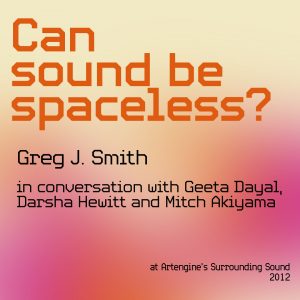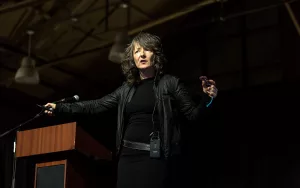Suzanne Kite, an Oglala Lakota performance artist, visual artist, and composer based in Montreal, weaves an intricate narrative that bridges her indigenous heritage with contemporary technology. Educated with a BFA in Music Composition from Bard College and currently a Ph.D. candidate at Concordia University, Kite’s work explores the intersection of art, technology, and cultural identity. Her projects often incorporate immersive video and sound installations, using technology such as body interfaces made from carbon fiber to create music and visual art that respond to the movements of the human body.
Kite has launched Unheard Records, an experimental electronic imprint, marking her entry into music production. Despite her extensive technical skills, she humbly acknowledges her ongoing learning journey, particularly in machine learning and the Lakota ways of knowing. Born in Los Angeles with familial ties in South Dakota, her work is deeply influenced by her Lakota heritage and her experiences as a diasporic individual.
In her recent artist talk, Kite shared insights into her artistic and personal evolution—from a classical violinist with aspirations to become a klezmer musician like her aunt, to a composer deeply interested in the emotional transcendence music can offer. Her current projects focus on the sonification and visualization of data, examining the limits of human perception and the capabilities of technology to enhance our understanding of complex phenomena. Kite’s work not only pushes the boundaries of artistic expression but also invites a rethinking of the relationships between sound, body, and technology in a culturally contextualized framework.
This presentation was part of the symposium ARTIFICIAL IMAGINATION which unites innovative artists engaged with emerging technologies. This focused on exploring and sharing their individual practices, experiences, and insights related to algorithms, artificial intelligence, and machine learning. It served as a platform for an enriching exchange of ideas between the artists and the audience, aiming to contribute a distinctive artistic viewpoint to the ongoing discussions about our evolving relationships with machine collaborators. Each session, including this one, highlighted how these technologies are being integrated and reflected in contemporary artistic processes, encouraging a broader understanding and appreciation of the creative potential of new digital tools.
Kite aka Dr. Suzanne Kite is an Oglála Lakȟóta performance artist, visual artist, and composer raised in Southern California, with a BFA from CalArts in music composition, and an MFA from Bard College’s Milton Avery Graduate School.
Known for her sound and video performance with her Machine Learning hair-braid interface, Kite’s groundbreaking scholarship and practice investigate contemporary Lakota ontologies through research-creation, computational media, and performance, often working in collaboration with family and community members.
Kite’s artwork and performance has been included in numerous exhibitions, recently Hammer Museum, Whitney Museum of American Art, Plug In Contemporary, PS122 and the Vera List Center, Anthology Film Archives, Walter Phillips Gallery, Chronus Art Center, Toronto Biennial, and Experimenta Triennial. Kite was a 2019 Pierre Elliott Trudeau Foundation Scholar, a 2020 Tulsa Artist Fellow, a 2020 Sundance New Frontiers Story Lab Fellow, a 2020 “100 Women in AI Ethics”, a 2021 Common Fields Fellow.
Kite is currently a United States Artist Fellow 2023, a 2022-2023 Creative Time Open Call artist for the Black and Indigenous Dreaming Workshops with Alisha B. Wormsley, and a 2023 Creative Capital Awardee.
Kite is currently Director of Wihanble S’a Lab, Distinguished Artist in Residence and Assistant Professor of American and Indigenous Studies, Bard College. She is a Research Associate and Residency Coordinator for the Abundant Intelligences (Indigenous AI) project.
Kite is an enrolled member of the Oglala Sioux Tribe.
I wanted to compose. But what I was desperate for and I’m still desperate for, and I don’t think I found it yet, is the feeling that when you’re playing a concert and I only had this feeling twice on stage ever, where, you know, it’s so well and it’s so deeply ingrained in your in your hands and your mind and you’re being you just are gone. You’re off the planet, you know, wherever you go. And so that is still kind of the impetus for my the way I compose and compose with the body and technology. So what I first started doing using tech more was when I wanted to learn data sonification and, and I study with Marcus McClure, who I was teaching a class at the time, and I wanted to make work about the phenomenon of like ceiling insanity, of tipping over into infinity, of counting, losing count in the point where you realize you stopped counting or last night we were we were having a conversation about when you’re writing something, then when I write, I just forget.
I just stop and realize I’m staring off into space for 20 minutes. And I thought I was just, I was writing. Um, uh, so, for example, I’m going to play a little clip when we hear many tones at around 80 tones within the human hearing range, we start to hear white noise. And the human brain finds it hard to hear the difference between a bandwidth of light with 80 tones and white noise, which is theoretically all tones at once. Then we played videos on and off, so you don’t need to lower them all the way every time because I’m going to play a bunch of them. And so that led me I that was the piece, this piece called Rocks, which is part of a larger piece called Omega, that I decided that physically placing the rocks on the ground and I had an accelerometer that triggered each sound was what I wanted to do. I wanted to experience the building of sound in time with the body. Um, so I. I decided I wanted to really focus on the body. So I was doing sonification, which is where you take data and you make it into sound visualization, or you take, uh, data and turn it into visuals. But then I was like, What does it mean to listen to data, see data, and then try to do it with the body? As I said, that was packed, was Asian. And so my goal has been to put these into communication with each other and involve the body. Then I built with my friend James Hurwitz at CalArts. I built my first body interface and this is the original version of it and it really hasn’t changed that much. I’m very committed to simplicity and it’s a great tool, even though the parts of it are like ten years old right now. Um, and these are the casings for various carbon fiber, and this is the first version of what it did.
My piece last year that I made, which was called Everything I Say Is True, um, I wanted to, I did it at Bard College and one of the professors there is Leticia Tsunami and she was, she’s amazing. She made the first hand controller, which is called the lady’s glove, and she recently got really into machine learning and she’s, um, she saw the piece that I was doing and the way I was trying to fit in technology. And she was like, no more direct relationships. Like, never again. You got to do something different. So I decided to jump in. This piece was important to me because I took all the tech out and I did this piece too. I mean, there’s some silly parts of it. It’s really long to sketch the outline of our desire, um, my desire as a native person and the audience, often the non-native audiences desire to see magic, technological magic. What does it mean to set up the expectation of control the body controlling technology and doing magic, doing magic. And I, and I, I often, I think it’s equivalent to a coin trick. Um, you know, and sometimes the coin trick is simpler. I’m just going to play it. So that was just one of the, some of the is more control and everything I say is true. Um, but I wanted to talk about this is some of the art of visual kind of stills from the, from that piece. Everything I say is true. So in this piece I wanted to talk about, um, I’m really into mapping. I mean, it’s hard not to be obsessed with mapping of the land as a native person. Um, you know, it’s like it’s an obsession. And I’m, and I’m obsessed with a specific hill where, um, my, my grandmother and mother are buried in South Dakota. And Kyle and I wanted to rethink time and mapping through Lakota language and Lakota epistemology.
I wanted to introduce something that’s new in my research. All ethnography is very fraught to deal with, but it is. This is this is pretty relevant. And I’m going to be recently so this is from I pulled this stuff out of a text called All My Relatives Exploring 19th century Lakota Ontology and Belief by this man. Posthumus And so I take this with a grain of salt as most things, but it’s very relevant, these and other conversations. So these conversations with with Scott and with Jason have led me to see how Lakota Epistemology is are far better suited for creating relations with the non-human Lakota. Ideas of the spirit in the nonhuman are influencing my hopes for working with machine learning and also rethinking the original ideas I had about circular systems in this text. Posthumous analyzes Lakota ontology through what is called the Skull Animism. And I don’t really like the term Animism, but we’ve got to go with it. Which distinguishes between two purposefully vague and inclusive concepts interiority. So that’s the soul, the spirit, the mind, the will, subjectivity, consciousness, intentionality, and the outside physicality, body materiality, manifest form habitus. So this means that interiority is especially distinct from Western ontologies and then animism quote allows for the extension of personhood and sociality to non-humans, thus abolishing the divide between nature and culture and animal societies and this includes objects.

Sound is inherently tied to space, it traverses. Once you start considering the possibility of a spaceless sound, you are delving into a realm of abstraction. Two types of re-encodings of sound that might be considered aspatial are the conversion of “vibrations moving through the air” to a digital signal and our memory of sonic events.

Tracey Lauriault provides a dynamic introduction to the relationship between data and the city at the Future Cities Forum. This talk delves into the social and technological infrastructure and frames a new more open and democratic version of a data centered city.